Top 5 first basemen in New York Yankees history
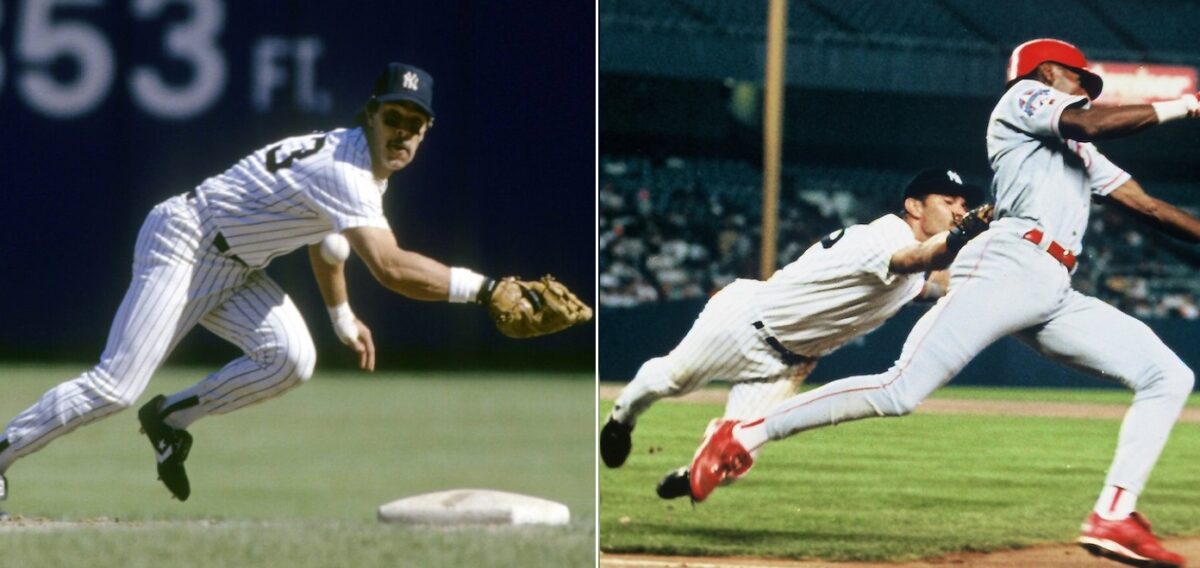
-
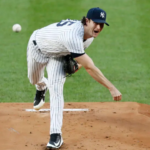 Joe Najarian
Joe Najarian
- April 3, 2024
- 1:09 pm
- One Comment
Table of Contents
With the New York Yankees having such an illustrious history, they have penciled many tremendous first basemen into their lineups.
In every Yankees dynasty, some of the biggest contributions to the team came from exceptional play at first base. Even better is that the position has had fantastic continuity; for example, Wally Pipp, arguably the first of the team’s first base mainstays, was replaced by the legendary Lou Gehrig. This has become especially apparent since the 1970s, with names such as Chris Chambliss, Don Mattingly, Tino Martinez, Jason Giambi, Mark Teixeira, and Anthony Rizzo forming an impressive line of succession as first base stalwarts.
Here are the finest five of all New York Yankees first basemen, who have become part of the Bronx lore.
#5. Mark Teixeira (2009-2016)
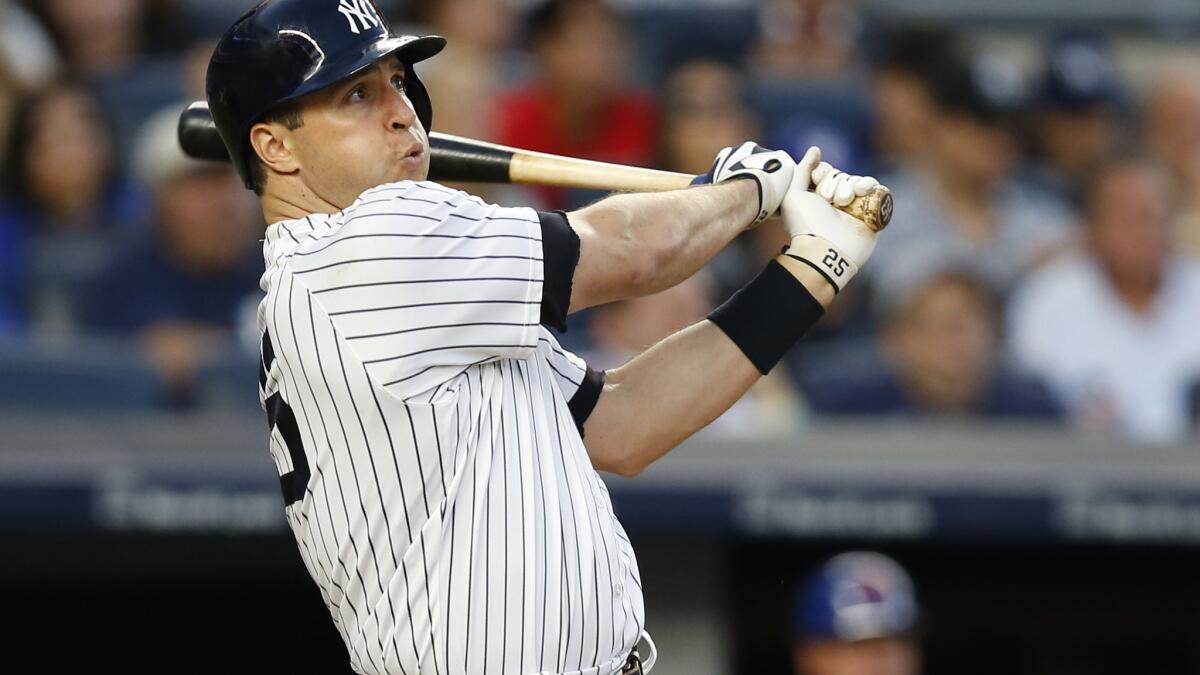
Despite not spending his prime years in pinstripes, Mark Teixeira’s status as a fan favorite is well deserved across his eight seasons in the Bronx.
A switch-hitter, Teixeira molded a fantastic power bat with excellent plate discipline and defensive prowess to accrue 45.1 fWAR in a 14-year career. He would play for the Texas Rangers, Atlanta Braves, and Los Angeles Angels before joining the Yankees, and ultimately concluded his career with 408 doubles, 409 home runs, 1,298 RBI, and a .268/.360/.509 slash line, while collecting five Gold Gloves, three Silver Sluggers, and a World Series title in 2009.
After two brilliant seasons in 2007 and 2008, both of which included mid-season trades, Teixeira signed a massive eight-year, $180 million contract to join the Yankees. Those eight years had its ups-and-downs, but the contract was worth it for his 2009 season alone.
Teixeira’s first season with the Yankees was a brilliant one, and there’s an argument that he was their best player that year. He absolutely pulverized opposing pitching to the tune of .292/.383/.565 and he shared the AL home run title with 39 long balls. He also accrued 43 doubles, scored 103 runs, and knocked in 122, while posting a 142 wRC+ and 5.2 fWAR. Teixeira’s contributions were recognized at the end of the season when he received both a Gold Glove and Silver Slugger Award, and finished second in AL MVP voting (behind only Joe Mauer).
Most importantly, he was an integral part of a Yankees World Series champion team; despite struggling in the playoffs by only hitting .180, “Tex” came through when it mattered most by hitting a walk-off homer in Game 2 of the ALDS against the Minnesota Twins, as well as a game-tying shot in Game 2 of the World Series against the Philadelphia Phillies.
The 2009 season would be Teixeira’s peak in pinstripes, but he remained productive despite dealing with injuries in ensuing seasons. Outside of 2013 (when he played in just 15 games before undergoing season-ending wrist surgery) and 2016 (his final season), he hit at least 20 homers in every season as a Yankee. He hit 33 and 39 bombs in 2010 and 2011, respectively, added two more Gold Gloves in 2010 and 2012, and enjoyed a resurgent All-Star campaign in 2015 by posting a .548 slugging percentage, a 143 wRC+ and 31 homers in just 111 games. Teixeira would end his Yankees tenure and career in style, as his final career home run was a walk-off grand slam that capped off a dramatic comeback against the Red Sox.
All told, Teixeira finished his eight years with the Yankees with a .248/.343/.479 slash line, 206 home runs, 622 RBI, and an 18.5 fWAR, while nabbing three Gold Gloves, a Silver Slugger, and the all-important 2009 World Series championship. While he isn’t an all-time great in franchise history, his power hitting, defensive prowess, and energy on the field made him beloved by the fanbase, and he’s still one of the most popular Yankees among younger generations of fans.
#4. Jason Giambi (2002-2008)
Jason Giambi’s legacy in pinstripes is rather complicated due to his use of performance-enhancing drugs and the team’s inability to win a World Series with him on the roster. However, when looking at his production with the team, “the Giambino” might be one of the most underrated Yankees stars.
Coming off two absolutely sensational seasons with the Oakland Athletics in 2000 and 2001, winning AL MVP in the former year, Giambi signed a seven-year, $120 million contract to join the Yankees, replacing Tino Martinez at first base. Like Teixeira, Giambi’s tenure had its ups-and-downs, but whenever he was on the field, the Yankees always had a great chance to win.
Giambi’s first season with the Yankees was his best, as he hit .314/.435/.598 with 34 doubles, 41 home runs, 120 runs scored, 122 RBI, a 175 wRC+, and 6.6 fWAR. He got off to a slow start to the 2002 season, but after hitting a dramatic, 14th inning, walk-off grand slam against the Minnesota Twins on May 17, the All-Star first baseman was off and running.
Despite being hampered by injuries in 2004 and 2007, Giambi justified his massive contract with his play on the field. His remarkable plate discipline and power resulted in a .404 on-base percentage and .521 slugging percentage across seven seasons; while his batting average was only .260, he made up for that by walking in nearly 17% of his plate appearances, hitting 134 doubles and 209 home runs, driving in 604 runs, and posting a 145 wRC+ and 21.8 fWAR.
The Yankees were unfortunately unable to win a World Series with Giambi on the roster; losing to the Florida Marlins in the 2003 World Series was the closest they’d get. However, it’s certainly not Giambi’s fault for failing to win a title, as he consistently performed at a high level in the playoffs. He hit .357 in the Yankees’ loss to the Anaheim Angels in the 2002 ALDS, and was one of the biggest factors in their Game 1 victory (a two-run homer in the fourth, and a game-tying single in the eighth). In fact, the Yankees wouldn’t even get to the 2003 World Series without the Giambino, as he hit two home runs off Pedro Martinez in Game 7 of the 2003 ALCS against the Red Sox; those two solo shots kept the Bronx Bombers within striking distance and set the stage for their ensuing dramatic victory.
There is one big reason why Giambi isn’t higher, though. Many would think that reason is his use of PEDs, but that doesn’t really hurt his ranking, especially considering that he’s obviously not the only Yankees star to use them. Instead, the reason is that Giambi, similar to Teixiera, didn’t have his peak years in pinstripes. Although his total hitting numbers between his time with the Oakland Athletics and Yankees are similar (147 wRC+ with Oakland, 145 wRC+ with New York), his two best seasons with Oakland (the aforementioned 2000 and 2001 seasons) were far better than any season he had in the Bronx; his 2001 season, when he finished second in MVP voting (behind Ichiro Suzuki), saw him hit a monstrous .342/.477/.660 with 47 doubles and 38 home runs, with an incredible 193 wRC+ and 9.2 fWAR. Outside of 2002, he didn’t come anywhere close to replicating that season.
In the end, Giambi finished his career with a .277/.399/.516 slash line with 405 doubles, 440 home runs, 1,441 RBI, and 49.8 fWAR. Even if the Yankees didn’t get Giambi at his absolute peak, what they did get was still-elite performances at the plate that gelled perfectly in the star-studded lineups of the Evil Empire era.
#3. Tino Martinez (1996-2001, 2005)
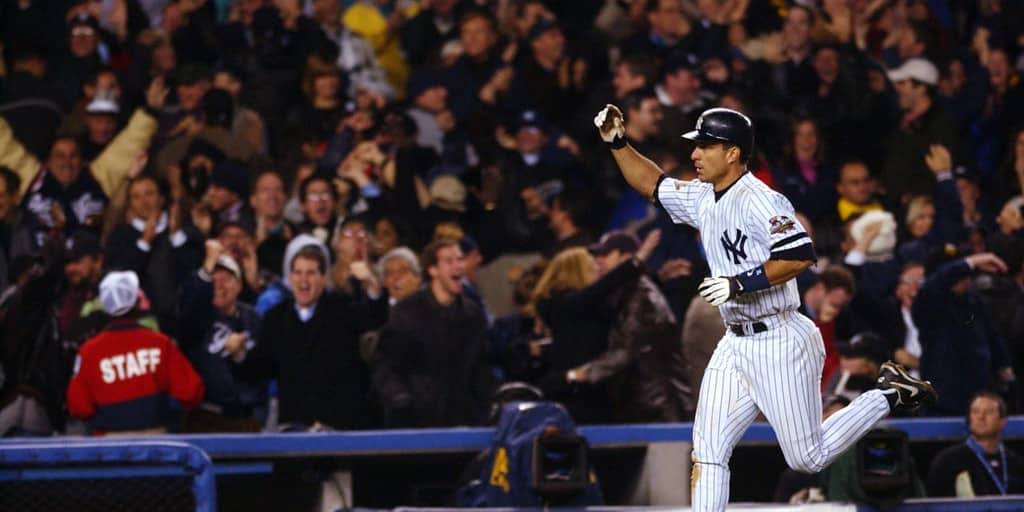
On December 7, 1995, the Yankees made a surprising trade with the Seattle Mariners, who were fresh off breaking the Bronx Bombers’ hearts in the 1995 ALDS. Sending third baseman Russ Davis and pitcher Sterling Hitchcock to the Emerald City, the Yankees got first baseman Tino Martinez and relief pitchers Jeff Nelson and Jim Mecir, with Martinez being the centerpiece of one of the best trades in franchise history (Nelson also enjoyed a successful Yankees career as an added bonus).
With Don Mattingly not returning after the 1995 season, the Yankees hoped that Martinez would be an admirable successor, as he was fresh off a breakout season. Playing for a Mariners team that effectively saved baseball in Seattle, Martinez stood out on a roster that also included Ken Griffey Jr. and Edgar Martinez by hitting .293/.369/.551 with 35 doubles, 31 home runs, 111 RBI, a 130 wRC+, and 4.5 fWAR. That season would be a sign of things to come in the Bronx.
From 1996 to 2001, Martinez would evolve into “the Bam-Tino”, and become an integral part of a dynasty, helping the Yankees win four World Series titles and five American League pennants in a six-year span.
Ironically, Martinez’s best season came in the year the Yankees didn’t win the pennant. In 1997, he hit .296/.371/.577 with 44 home runs, 141 RBI, a 141 wRC+, and 5.3 fWAR, all of which were career-best marks. He additionally was named an All-Star, won the Home Run Derby, captured the only Silver Slugger Award of his career, and placed second in MVP voting (behind only Ken Griffey Jr., who won the award unanimously).
But outside of a down season in 2000, Martinez was as dependable as they come over his initial six-year tenure. Over that span, he hit .279/.348/.488 with 180 doubles, 175 home runs, 690 RBI, a 114 wRC+, and 15.8 fWAR. Batting within the heart of the batting order, he was a cornerstone of a remarkably balanced lineup, and was the home run leader (28) of the legendary 1998 team.
As mentioned before, the Yankees were a dynasty when Martinez was on the team, winning four championships, including a three-peat. Naturally, the first baseman had several huge moments in the playoffs, and in particular has two of the most iconic World Series moments in team history. In Game 1 of the 1998 World Series, Martinez faced San Diego Padres lefty Mark Langston in the seventh inning of a 5-5 game, with two outs and the bases loaded. With the count full, the Bam-Tino crushed a decisive grand slam into the right field upper deck, giving the Bronx Bombers a 9-5 lead and sending them on their way to an eventual sweep. In Game 4 of the 2001 World Series, Martinez had yet to get a hit in the series when he came up in the bottom of the ninth inning with a man aboard, the Yankees trailing 3-1, and one out away from defeat; facing Arizona Diamondbacks closer Byung-hyun Kim, he jumped on the first pitch and drove it over the right-center field wall to tie the game, unleashing one of the loudest deafening roars from the Yankee Stadium crowd. The Yankees eventually won the game on Derek Jeter’s “Mr. November” walk-off homer one inning later.
After two seasons with the St. Louis Cardinals and another with the Tampa Bay Devil Rays, Martinez returned to the Yankees in 2005 for one last season. Although he only hit .241/.328/.439, the Bam-Tino added a final tale to his playing legend by hitting eight home runs in an eight-game span from May 7-15; this included five home runs in five consecutive games from May 7-11.
Overall, Martinez hit .276/.347/.484 with 192 home runs, 739 RBI, and 16.0 fWAR in a Yankees uniform; across his career, he hit .271/.344/.471 with 365 doubles, 339 home runs, 1,271 RBI, a 110 wRC+, and 28.7 fWAR. While these numbers pale in comparison to Teixeira and Giambi, Martinez gets the edge over both because he not only had his best years in pinstripes, but is immediately recognized as a Yankees player before any of the other teams he played for. His role in the modern Yankees dynasty gave him a plaque in Monument Park, and he remains one of the most beloved players in franchise history.
#2. Don Mattingly (1982-1995)
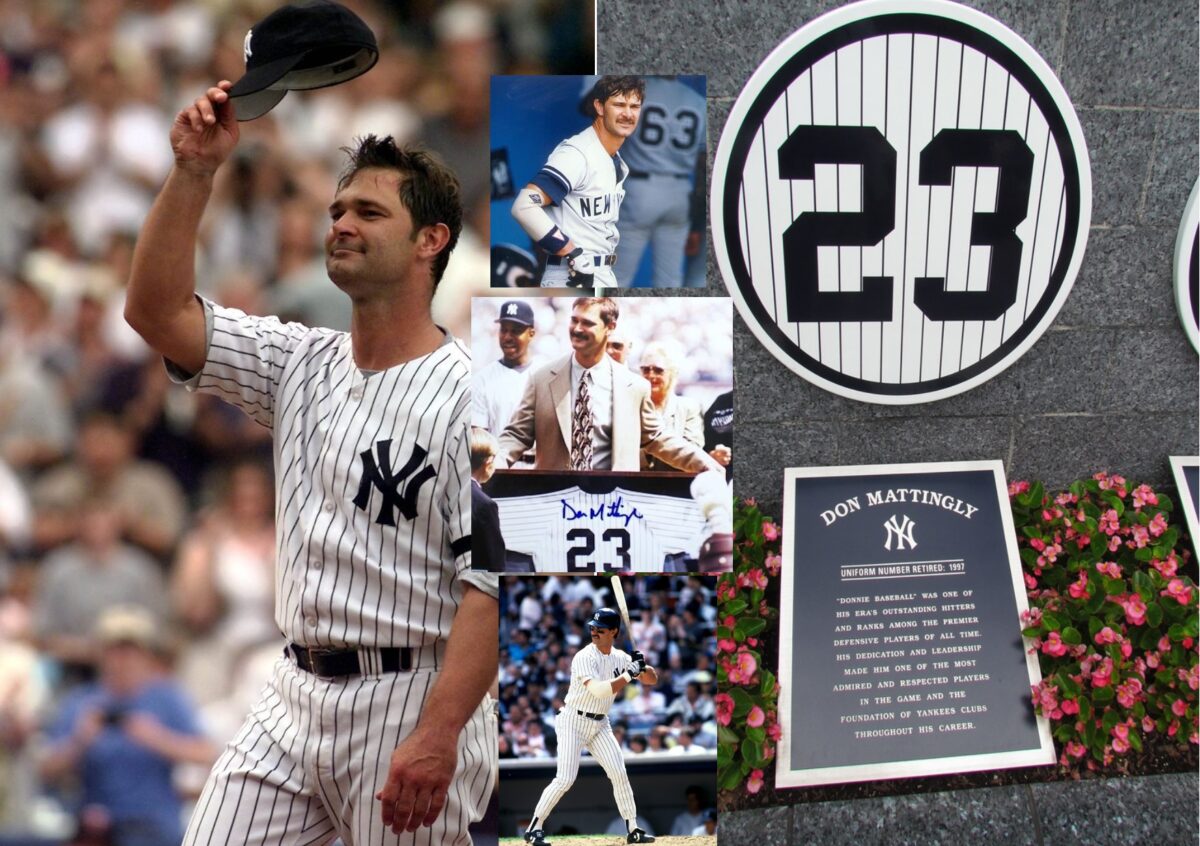
It’s an outright tragedy that Don Mattingly was unable to win a World Series with the Yankees; the meddlesome nature of late owner George Steinbrenner and playing most of his career in the pre-Wild Card era prevented Mattingly from even competing in the playoffs until the final season of his career.
But despite the lack of team success, “Donnie Baseball” (or “the Hit Man”) gave the Yankees everything he had in every game, and his efforts would be rewarded by an enshrinement in Monument Park; no Yankee has ever worn number 23 ever again, and for good reason. Mattingly was not only the most adored Yankees star of his generation, but he also enjoyed a fantastic peak in the mid-1980s where he was one of the absolute best players in baseball.
After a cup-of-coffee in 1982 and a solid-but-unspectacular rookie season in 1983, Mattingly broke out big time in 1984. He won the batting title over teammate Dave Winfield with a .343 average, and his .537 slugging percentage was the second-highest in the American League. His AL-leading 207 hits also included 23 home runs and an MLB-best 44 doubles. Overall, Mattingly registered a 153 wRC+ and 6.1 fWAR, while providing a prelude of things to come.
From 1984 to 1989, Mattingly slashed .327/.372/.530 with 257 doubles, 160 home runs, 684 RBI, 581 runs scored, a 143 wRC+, and 31.7 fWAR, while also becoming one of the greatest defensive first basemen of all time with 33 total zone fielding runs across his career. He was named an All-Star each year, won five consecutive Gold Gloves from 1985-1989, won three consecutive Silver Sluggers from 1985-1987, and was named the 1985 AL MVP. While he didn’t walk much due to his aggressive hitting style, Mattingly was extremely difficult to strike out, with a 5% strikeout rate across those six peak years.
Mattingly lived up to his Donnie Baseball nickname in 1985 and 1986, where he was arguably the best player in baseball. In his 1985 MVP season, he hit .324/.371/.567 with 211 hits, an MLB-leading 48 doubles and 145 RBI, a career-best 35 home runs, a 151 wRC+, and 6.1 fWAR. Despite finishing second in MVP voting (behind only Roger Clemens) in 1986, Mattingly followed up the MVP campaign with the best season of his career; he posted a 7.2 fWAR and slashed .352/.394/.573 with 31 home runs and 113 RBI. His .573 slugging percentage, .967 OPS, 160 wRC+, 388 total bases, 238 hits, and 53 doubles were all the most in the major leagues, while the latter two broke franchise records that had stood since 1927 and still stand today. In 1987, the Hit Man established a new single-season record by hitting six grand slams (which surprisingly were the only grand slams of his career), and tied an MLB record by hitting eight homers in eight consecutive games (July 8-18); he still shares both of these records.
Sadly, the Yankees were unable to build a playoff team around Mattingly until 1995; by then, he was only 34 but well-past his prime due to severe back injuries that kept him off the field and sapped his power. He was still a good contact hitter and a great defender, winning four straight Gold Gloves from 1991-1994, but he would not return to the team after playing in the only postseason series of his career, a heartbreaking loss to the Seattle Mariners in the 1995 ALDS. Mattingly made the most of his one playoff opportunity, hitting .417 with six RBI and an electrifying home run in Game 2, but he retired in 1997 due to his ailing back. The Yankees won the World Series the year after he left the team and won the pennant the year before making his MLB debut, making his tenure a case of truly unfortunate timing.
Nonetheless, with career totals that include a .307/.358/.471 slash line, 2,153 hits, 442 doubles, 222 home runs, 1,099 RBI, a 124 wRC+, 40.7 fWAR, nine Gold Gloves, three Silver Sluggers, and an MVP award, all accomplished in pinstripes, the Yankees immediately showed their appreciation by retiring Mattingly’s number on August 31, 1997. He was the face of the franchise during a difficult time and was the reason why many became a Yankees fan, including my father. While his career saw a lot of bad luck, he still immortalized himself as a Yankees legend and the second-best first baseman in the team’s illustrious history.
And for the best?
#1. First Yankees legend Lou Gehrig (1923-1939)
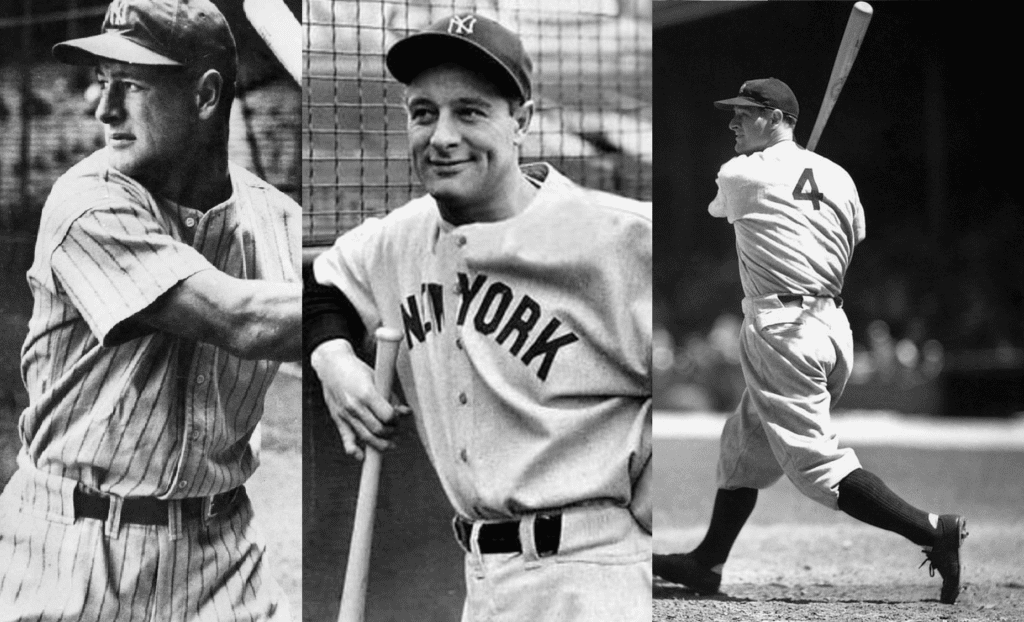
I mean… how is he not?
Henry Louis Gehrig, aka “the Iron Horse” isn’t just the best first baseman in Yankees history, but he’s the greatest first baseman in the history of baseball, a statement that, quite frankly, isn’t even debatable.
Only a fatal diagnosis of amyotrophic lateral sclerosis (ALS) could stop Gehrig, who is one of just seven players ever to have a career OPS over 1.000. He retired with a truly incredible slash line of .340/.447/.632 alongside 2,721 hits, 534 doubles, 163 triples, 493 home runs, and 1,995 RBI. His career on-base percentage is the seventh-best all-time, his career slugging percentage and OPS ranks third all-time, his RBI total is sixth all-time, and his 171 career wRC+ ranks fourth-all time, behind only Babe Ruth (first), Ted Williams (second), and Barry Bonds (third). He has the highest fWAR of any primary first baseman in history, with 115.9. As a cherry on top, he did all this while playing every single game from June 1, 1925 to April 30, 1939.
After limited playing time in 1923 and 1924, Gehrig got his chance when he replaced Wally Pipp on that fateful day in June 1925. He quickly developed into a valuable contributor, hitting .295 and .313 with 20 and 18 home runs, respectively; he also clubbed 47 doubles and 20 triples in 1926, the latter of which led the American League.
And then came 1927.
Batting cleanup behind Babe Ruth, who hit 60 home runs that year, Gehrig complimented his teammate’s record-setting season by putting together one of the greatest offensive seasons in history himself. He batted a monstrous .373/.474/.765 for a ridiculous 205 wRC+. Of his 218 hits, over half of them (117) went for extra bases, with 52 doubles, 18 triples, and 47 home runs. Despite having Ruth clear the bases 60 times before his at-bats, Gehrig drove in a then-record 175 runs. Ultimately, the Iron Horse accumulated a transcendent 12.4 fWAR, and was recognized with the first AL MVP award of his career. Ruth even credited Gehrig’s efforts as a key factor in his 60-homer season: “Pitchers began pitching to me because if they walked me, they had Lou to contend with.”
Gehrig’s breakout resulted in the creation of an unstoppable one-two punch with Ruth in the lineup, and the birth of the “Murderer’s Row” lineup. The Yankees would go on to win the World Series that year, the first with Gehrig on the team; he would go on to win five more in his career.
From 1927 to 1938, Gehrig accumulated 105.5 fWAR and drove in 1,800 runs. Counting his 1926 season, he had 100 or more RBI in 13 consecutive seasons, hit over .300 every year from 1926-1937, and hit 30 or more home runs every year from 1929-1937. He had seven seasons with 150 RBI or more, with his 185 RBI in 1931 ranking second all-time in a single season (behind Hack Wilson’s 191 RBI in 1930) and still standing as the American League record. Even with Ruth ahead of him in the lineup, Gehrig was arguably the greatest run producer in the history of the game.
Furthermore, Gehrig wasn’t just consistent, he was consistently dominant; 1927 wasn’t the only all-time great offensive season he’d have. In 1934, he hit .363/.465/.706 with 49 home runs and 166 RBI to claim the Triple Crown; somehow, this wasn’t enough for him to win AL MVP despite a 193 wRC+ and 10.7 fWAR. That second MVP would come in 1936, and it was well deserved: the Iron Horse matched his career-high of 49 long balls while also hitting .354/.478/.696 and driving in 152 runs.
Finally, it’s impossible to talk about Gehrig without mentioning his consecutive games streak. Said streak would reach a truly unfathomable mark of 2,130; while the legendary Cal Ripken Jr. famously surpassed that total and extended his own streak to a effectively unbreakable 2,632 games, it’s highly unlikely that Gehrig’s total will ever be surpassed again due to changes in today’s game.
Sadly, Gehrig would never play another game after his streak ended. Although his 1938 season (.295/.410/.523, 29 homers, 114 RBI) would be an excellent season in any era of baseball, it was a drastic decline from his usual career norms. By 1939, while Gehrig was still capable of making contact at the dish, his power was completely gone, and both his fielding and baserunning were rapidly declining. On May 2, 1939, he voluntarily took himself out of the lineup, and eventually received the dreaded ALS diagnosis (the disease was eventually nicknamed “Lou Gehrig’s Disease” due to his diagnosis spreading awareness of the ailment in the United States). Gehrig died just two years later from the disease, on June 2, 1941. He was only 37.
Even with ALS tragically cutting his career and life short, Gehrig accomplished far more in his career than almost anyone else did. In addition to all the statistics and World Series victories, he became the first player in MLB history to have his number retired, is immortalized in the Baseball Hall of Fame, has a philanthropic award (the Lou Gehrig Memorial Award) that bears his name, and even has his own day (June 2) declared by Major League Baseball. His status as the greatest first baseman ever, Yankee or otherwise, has continued to grow in esteem, and he will forever be remembered as not only one of the single greatest players to ever step on the diamond, but as a true ambassador of the game as a whole.
If the always humble and grateful Gehrig got to live longer and see the impact he had on the baseball world, both on and off the field, he would continue to consider himself “the luckiest man on the face of the Earth”.
There will never be another Lou Gehrig.
Honorable Mentions:
Wally Pipp– Although best remembered as Lou Gehrig’s predecessor, Wally Pipp was also one of the best power hitters of the dead-ball era, with 80 home runs in a Yankees uniform from 1915 to 1925. His 11 years with the Bronx Bombers saw him hit .282/.343/.408 and drive in 833 runs, and he helped the Yankees win their first championship in 1923 by collecting 109 RBI. He led the majors in homers in 1916, albeit with just 12.
Bill Skowron– A key contributor to Casey Stengel and Ralph Houk’s squads in the late 1950s and early 1960s, “Moose” Skowron spent nine years in pinstripes and hit .294/.346/.496 while winning four World Series titles. Platooned with Joe Collins early on, Skowron became the undisputed first baseman from 1958 onwards and hit 165 homers with 672 RBI over his tenure. He hit 20 or more homers each year from 1960-1962 to help lead the Yankees to three straight pennants, and was essential to the team’s victory in the 1958 World Series by driving in the winning run in Game 6 and sealing Game 7 with a three-run shot.
Chris Chambliss– A mainstay of the “Bronx Zoo” Yankees teams from the 1970s, Chambliss hit .282/.323/.417 in pinstripes while making an All-Star appearance in 1976 and winning a Gold Glove in 1978. He had 454 RBI and 79 home runs from 1974-1979, but no home run was bigger than his pennant-clinching homer in Game 5 of the 1976 ALCS against the Kansas City Royals. Yankees fans stormed the field in celebration of Chambliss’s historic shot, but considering the Yankees had won their first pennant in 12 years, you can’t really blame them for being excited.
What do you think? Leave your comment below.
- Categories: don mattingly, jason giambi, Lou Gehrig, mark teixeira, tino martinez, Yankee Legends
- Tags: don mattingly, jason giambi, Lou Gehrig, mark teixeira, tino martinez, Yankee Legends
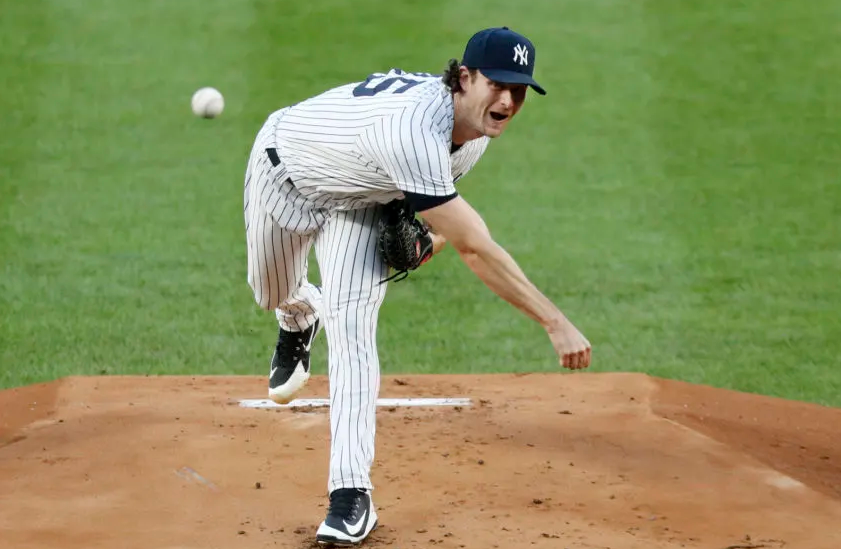
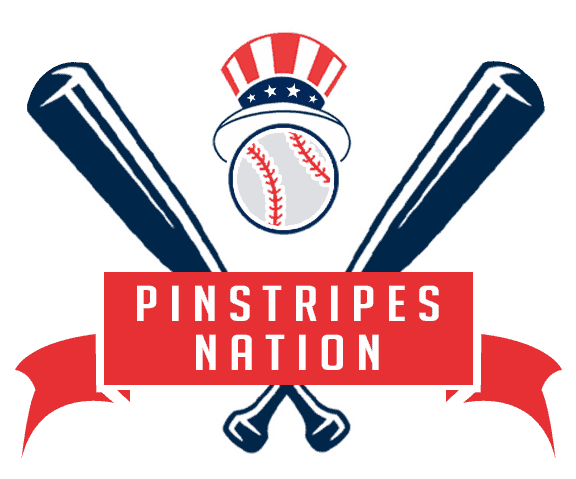
 Follow Us
Follow Us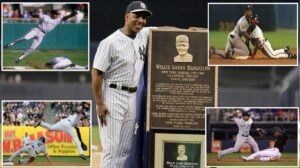
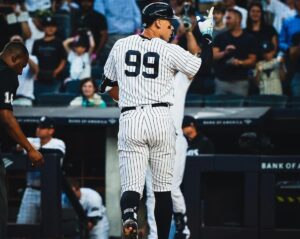
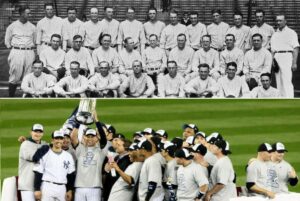
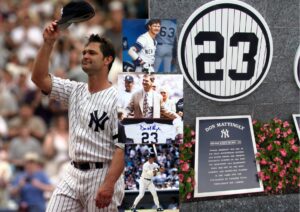





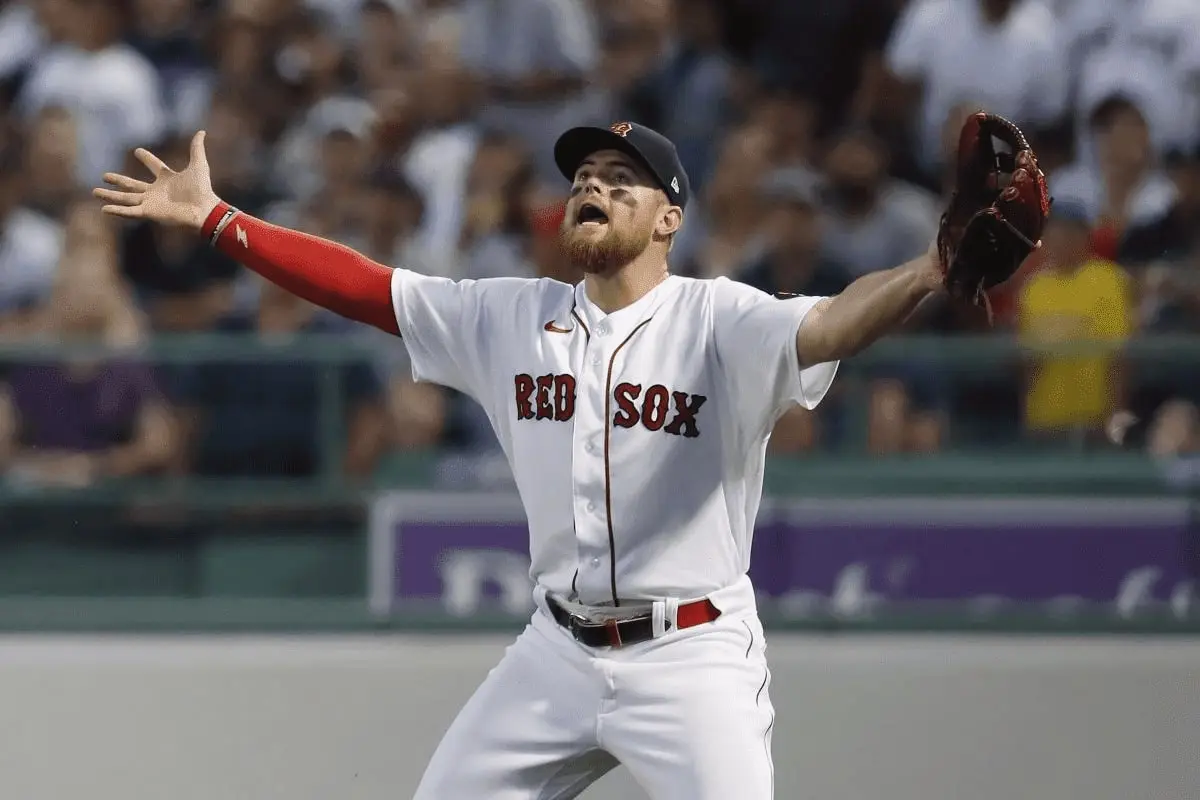
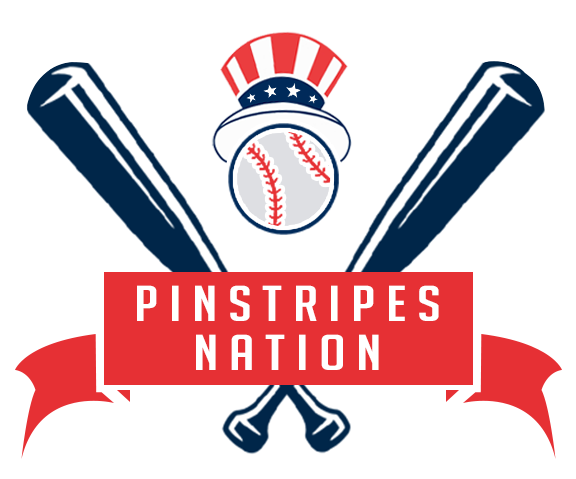
One thought on “Top 5 first basemen in New York Yankees history”
Jason Giambi 4th?!!! Try about 8th or 9th, at best.
Chris Chambliss was Markedly Better than Giambi, Without the Benefit of Illegal Steroids! He helped Win 2 World Series & batted .281 in 7 Playoff Series. He batted .282 with an OBP of .323 in his 7-year Yankee career, and he hit one of the Most Memorable HRs in Yankee History; and he won a Gold Glove at first, whereas Giambi’s glove was made of lead.
“Moose” Skowron (nobody called him Bill) was an All-Star for 5 Consecutive seasons in his 9-year Yankee career and, again, he did that Without the Benefit of Illegal Steroids! A fan favorite, Moose helped the Yankees get into 7 World Series, and was a key player in helping them Win 4 World Series with his .293 BA, .519 SLG %, and 7 HRs. For his Yankee career, he batted an impressive .294 with a .346 OBP and 166 HRs.
Even Joe “You Could’ve Made Us Proud” Pepitone had a more noteworthy Yankee career than Gambi, and he did it sporty a wig, instead of Steroid-filled needle in his butt. “Pepi” Won 3 Gold Gloves as a Yankee first baseman & would have won more if he didn’t switch to CF to allow Mickey Mantle to switch to 1B to extend his illustrious career. Pepi also appeared in 2 World Series in which he was awful, batting just .145, much like Giambi, who was also awful in his 1 Yankee WS. Pepitone finished in the Top 10 in HRs or RBIs 5 times in his 8-year Yankee career, and other than Don Mattingly, Peptone was the slickest fielding 1B in the last 60 years of Yankee baseball, whereas Giambi was a minor disaster as a 1B.
And, yes, even mostly forgotten Wally Pipp had a more illustrious Yankee career. As noted in the article, Pipp helped the Yankees garner their first of 27 World Series titles, a total to which Giambi added ZERO when he batted a Pathetic .235 with ONE RBI in the horrible 6-game loss to the Miami Marlins in 2003.
Btw, Giambi’s Championship Win Probably Added percentage (cWPA) for his 1 World Series appearance with the Yankees in 2003 was -10.3%. That’s MINUS 10.3%, as in, boy did he suck.
Giambi’s Steroid use alone precludes him from any serious list of the best Yankee first basemen in history.
Similarly, while I admire A-Rod’s extensive knowledge of the game, his innate ability & his work ethic, his Steroid use as a Yankee (and prior to that time in Texas) precludes him from serious consideration as an all-time great Yankee 3B. That title still goes to Greg Nettles, whose worst transgression as a Yankee was being dumb enough to think that hollowing out a baseball bat & putting 6 super balls inside it was a good idea; it was hilarious, however, when the super balls came tumbling out of the bat on a broken-bat “single” that was changed to an out (for some reason ;-). Nettles, himself, later got “bounced” for 10-games for that stunt.
FOR YOUNGER FANS: “SUPER BALLS” were extremely hard rubber balls, smaller than golf balls, that, when thrown hard on the ground, would bounce about 10-20 feet in the air. But putting them inside a hollowed-out wooden bat would gain you Absolutely Nothing (!), except a lighter bat to swing with and an extremely embarrassing moment when said bat broke & super balls bounded across the diamond.
SADLY, you’ll never see that moment on Yankee Classics, even though it’s likely the funniest moment in Yankees History. ;-(